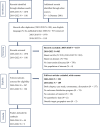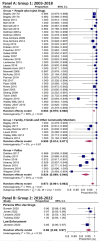Effectiveness of naloxone distribution in community settings to reduce opioid overdose deaths among people who use drugs: a systematic review and meta-analysis
- PMID: 40133970
- PMCID: PMC11934755
- DOI: 10.1186/s12889-025-22210-8
Effectiveness of naloxone distribution in community settings to reduce opioid overdose deaths among people who use drugs: a systematic review and meta-analysis
Abstract
Background: It is estimated that over 111,000 people in the U.S. died from a drug overdose in the twelve-month period ending in July 2023. More than three-quarters of those deaths were attributed to opioids. Naloxone has long been available in healthcare facilities to reverse opioid overdose rapidly and safely but is not universally accessible for use in community settings where overdoses occur. We conducted a systematic literature review and meta-analysis to assess the effectiveness of overdose education and naloxone distribution (OEND) programs in three types of community settings to reduce overdose deaths among people who use opioids nonmedically.
Methods: We systematically searched electronic databases, including Medline (OVID), Embase (OVID), Psycinfo (OVID), and Global Health (OVID), for peer-reviewed studies of OEND programs published during 2003-2018 (Group 1) that reported overdose outcomes individual level survivals or deaths immediately following naloxone administration. The PRISMA checklist guided screening, quality assessment, and data abstraction. We later identified studies published during 2018-2022 (Group 2), when drug usage and fentanyl-related overdose deaths notably increased, differed from earlier ones. We conducted meta-analyses on both Groups using random effects models to estimate summary survival proportions.
Results: Among the 44 Group 1 studies published during 2003-2018, survival did not differ by time (year), location, naloxone dose, or route of administration, but studies of OEND programs serving people who use drugs reported 98.3% (95% CI: 97.5-98.8) survival; those serving family of people who use drugs or other community members reported 95.0% (95% CI: 91.4-97.1) survival; and those for police reported 92.4% (95% CI: 88.9-94.8) survival (p < 0.01). Five Group 2 studies (2018-2022) yielded similar results.
Conclusions: Community-based naloxone distribution programs can be effective in preventing opioid overdose deaths. The paper demonstrates that in the face of increasing overdose deaths over time, survival after naloxone administration has been sustained. The very high survival rates provide clear evidence for public health to continue efforts to expand channels for naloxone distribution in community settings.
Keywords: Injection drug use; Naloxone; Opioid; Overdose; Police; Prevention; Syringe services programs; Systematic review.
© 2025. This is a U.S. Government work and not under copyright protection in the US; foreign copyright protection may apply.
Conflict of interest statement
Declarations. Ethics approval and consent to participate: This activity was reviewed by the Centers for Disease Control and Prevention (CDC) and was conducted consistent with applicable federal law and CDC policy. See e.g., 45 C.F.R. part 46; 21 C.F.R. part 56; 42 U.S.C. § 241(d), 5 U.S.C. § 552a, 44 U.S.C. § 3501 et seq. Consent for publication: This paper does not contain any individual, personal identifying information, and accessed only previously published anonymous and aggregated data. There was no human participation or human subjects involved in this study. Competing interests: The authors declare no competing interests. Author disclaimer: The findings and conclusions in this manuscript are those of the authors and do not necessarily represent the views of the Centers for Disease Control and Prevention. Human ethics and consent to participate declarations: This project only used previously published anonymous and aggregated data and was determined to be “Exempt Human Subjects Research” (under U.S. Federal statute 45 CFR 104(D) 1–8).
Figures


References
-
- Centers for Disease Control and Prevention. Unintentional and undetermined poisoning deaths—11 states, 1990–2001. MMWR Morb Mortal Wkly Rep. 2004;53(11):233-8. PMID: 15041950. - PubMed
-
- Spencer MR, Miniño AM, Warner M. Drug overdose deaths in the united States, 2001–2021. NCHS Data Brief. 2022;457:1–8. PMID: 36598401. - PubMed
-
- Carroll JJ, Green TC, Noonan RK. Evidence-based strategies for preventing opioid overdose: what’s working in the United States. Atlanta, GA: Centers for Disease Control and Prevention, 2018. http://www.cdc.gov/drugoverdose/pdf/pubs/2018-evidence-based-strategies.pdf
-
- Davis CS, Carr D. Legal changes to increase access to Naloxone for opioid overdose reversal in the united States. Drug Alcohol Depend. 2015;157:112–20. 10.1016/j.drugalcdep.2015.10.013. - PubMed
Publication types
MeSH terms
Substances
LinkOut - more resources
Full Text Sources
Medical

